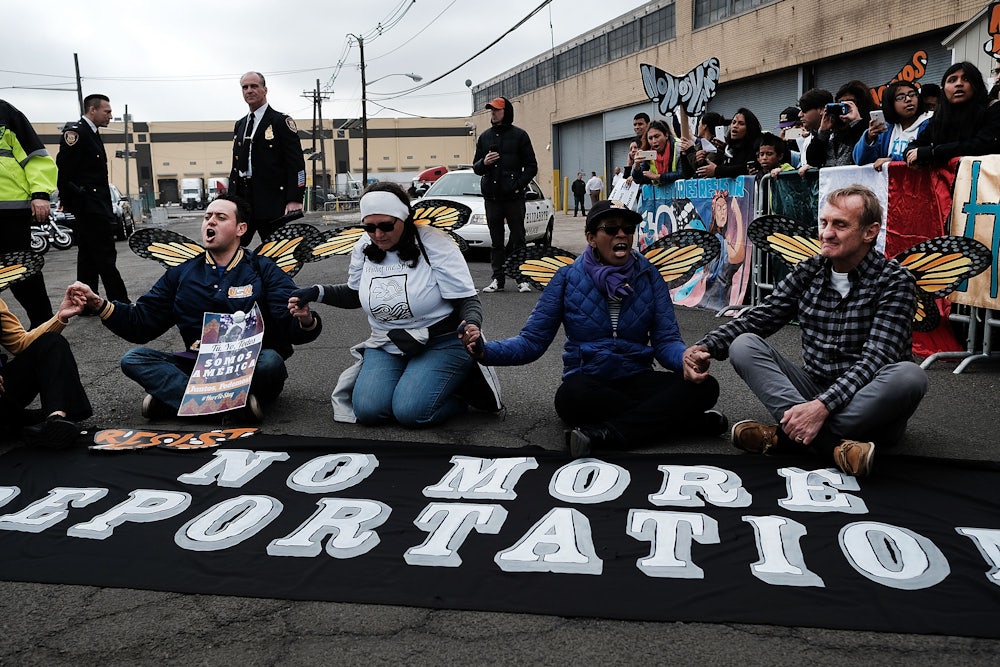Doremus Avenue, about 10 minutes north of Newark International Airport, is not an ideal setting for a rally. The road carries truckers, mostly, with business at Port Newark, and on a sunbaked Tuesday morning this June, their rigs were drowned out by speeches from members of the Abolish ICE NY-NJ coalition. The activists didn’t mind when a supportive horn blared over their words. It was a small demonstration by their usual standards, held in front of Essex County Correctional Facility, one of four facilities in the state that have been used to detain undocumented people for Immigration and Customs Enforcement.
The group had gathered to protest the imminent transfer of immigrants inside the facility to out-of-state jails—people they wanted ICE to release instead. Among the attendees was one detainee’s mother and another’s wife. Eventually, news broke that 32 of the 39 people they’d been concerned about had already been moved at 4:30 a.m., almost three hours before organizers showed up. The group began to clear out, but after a year’s worth of similar gatherings, the chorus of “see you laters” was heartfelt.
The Garden State, second only to California when it comes to the percentage of immigrants in the state’s population, is the site of a recent victory for immigrants rights advocates in the fight over the longstanding practice of local jails working with ICE.
Over the past year, poor conditions and ill treatment in county jails, made worse by the pandemic, have led incarcerated immigrants to protest with hunger strikes and other actions, while, on the outside, increasingly confrontational activism aimed at abolishing ICE’s presence in the region has gained steam. At the same time, advocates pushed legislation banning future contracts with ICE to Democratic Governor Phil Murphy’s desk, where it was signed last Friday. As of August 20, county officials and private detention facilities are barred from inking new ICE contracts, making New Jersey the fifth state to ban or limit ICE detention.
While the bill’s passage was cause for celebration, it leaves existing agreements with county jails in place. The potential for an ICE-free New Jersey beckons, but anti-detention advocates won’t be satisfied if people are just moved to another state—as ICE is currently doing. They are not just looking to cut ICE out of county budgets, advocates say. They are demanding “releases, not transfers”: immediate freedom for everyone currently detained.
Of the four New Jersey facilities that take part in federal immigration detention, Elizabeth Detention Center was the first to sign a contract with the Immigration and Naturalization Service in 1993. Conditions were so poor at the privately run facility (the only one in the state) that there was an uprising inside in 1995. The next year, the Illegal Immigration Reform and Immigrant Responsibility Act passed Congress and Hudson County, New Jersey, signed its first contract with INS. The law made it easier to arrest, detain, and deport undocumented immigrants, with an emphasis on detention. This led to a massive expansion in the number of beds reserved for detained immigrants—from 6,785 a night in 1994 to 48,850 in 2019.
Bergen County followed Hudson’s lead in 1997, and a 2008 Essex County contract rounded out the quartet. After three years, Essex became ICE’s largest holding pen in New Jersey, more than doubling its capacity to hold 1,250 federal immigration detainees. People are held indefinitely, based on the progress of their immigration cases; many spend months inside, if not years. Immigrants arrested in New York City are often moved to New Jersey, especially when their arrests are violent enough to elicit media scrutiny. Indeed, throughout Barack Obama’s second term as president, New Jersey “served as an immigration detention hub” in the Northeast, according to Chia-Chia Wang, the organizing and advocacy director at the American Friends Service Committee in Newark.
These contracts, signed by county-level officials, flew mostly under the radar for years, despite periodic reports of mistreatment at all four facilities. The inauguration of Donald Trump, however, completely changed the organizing landscape. Emboldened by Trump’s fervently anti-immigrant policy and rhetoric, ICE conducted raids in cities like Newark, Jersey City, and Union City, disappearing undocumented community members at a rapid tilt. The pace was astounding: In 2017, three immigrants without a criminal record were arrested per day in New Jersey.
Citizens swimming in the broadly liberal stream of Jersey politics were appalled by grim accounts from immigrants in custody as the counties they called home cashed in on incarceration. In the early wave of resistance to the Trump administration’s policies, new organizations and coalitions formed. Anti-detention work ramped up alongside existing campaigns for driver’s licenses for undocumented people and housing rights. A 2019 protest by the immigrant-led organization Movimiento Cosecha and the Jewish group Never Again Action drew a crowd to block Elizabeth Detention Center’s entrance, demonstrating the groundswell of direct opposition to local jailing.
Covid-19 shifted the terrain again, with resistance among incarcerated immigrants and the volume of organizations involved in combating ICE both increasing over 2020. The terrifying conditions faced by immigrants inside was the galvanizing factor, but the pandemic also allowed homebound organizers to better coordinate. The group chat behind the Abolish ICE NY-NJ coalition—made up of members of faith organizations, democratic socialists, abolitionists, academics, legal service providers, and more—exploded, sustaining participation and turnout for events through lockdown. Anti-ICE activists staged car caravans, like one surrounding Hudson County Jail on March 22, 2020, and hunger strikes began inside Essex County Jail at the onset of Covid.
In the first six months of the pandemic, ICE released thousands of people, and the number of immigrants in detention dropped from over 38,000 to around 20,000—but that number was far too high for advocates nationwide to claim victory.
Last summer’s uprisings challenging police power and questioning the carceral state also added to the ranks of resisters in North Jersey. In Ridgewood village in Bergen, a group of students at the local public high school formed Ridgewood for Black Liberation, which expanded its efforts from advocating for a more expansive school curriculum to organizing rallies during the summer to helping halt deportations at Bergen’s jail.
“After the summer died down, we shifted our focus to anti-ICE abolitionist work at Bergen County Jail specifically,” explained a founding member of the organization, who asked not to be named because they have a pending case in Bergen County. “Because we knew that that jail held ICE detainees in addition to other incarcerated people, we wanted to advocate for them.”
The fall and winter of 2020–2021 turned out to be the peak of organized resistance inside New Jersey jails. Hunger strikes (defined by ICE as sustained refusal of the meals it provides, with food from the commissary not taken into consideration) of varying duration broke out in Bergen, Essex, and Hudson. Some lasted weeks, with one striker holding out more than a month. “We lost count of how many hunger strikes were led by people inside these facilities,” said Haydi Torres, an organizer with Movimiento Cosecha.
Immigrants also instigated other acts of refusal, like declining to enter their cells on command, and reached out to the media with unusual frequency. Complaints compelled a local news station to tour Bergen County Jail, where detainees yelled, “We don’t have clean water!” and alleged that staff had done a last-minute cleanup for the cameras.
People held in the Bergen jail have long claimed that staff retaliate against detainees who speak up about conditions inside. In July, people detained in Bergen claimed that authorities retaliated against hunger strikes by transferring people to different detention facilities—with the result that local immigration lawyers had to find their clients days later in other states, where communication could be strained and more costly.
The legislation just signed by Governor Murphy doesn’t address the conditions of currently incarcerated people, but it was their protests that helped it get passed.
Amy Torres, executive director of the New Jersey Alliance for Immigrant Justice, said the push to get the state to ban new ICE contracts started in response to the agency’s requests for information on new detention sites in and around New Jersey last October, which could’ve boosted capacity by more than 900 beds.
“Advocates came together and proposed this bill as a means to build the dam upstream and make sure that we wouldn’t be inundated with new sites,” she said.
After a month of consistent hunger strikes inside and vigils outside of Bergen’s jail, which escalated to a scuffle with cops days before Christmas, the bill was introduced in the State Assembly on January 4. The very next day, ICE revealed that protests had spread to Essex County Jail—11 people had been refusing meals and requesting their release since New Year’s Eve.
Agitation continued, with rallies, zines, hunger strikes, phone zaps, and canvassing. At the end of April, dominoes began to fall: Essex County revealed plans to stop immigrant detention, and in a matter of days, vague plans to do the same emerged in Bergen and Hudson.
However, the reasoning from administrators was far from encouraging to advocates. With immigrant detention at all-time lows due to the pandemic, Essex found it more lucrative and less controversial to start using their capacity to incarcerate nonimmigrants from neighboring Union County. In Bergen, Sheriff Anthony Cureton discussed holding federal inmates with the U.S. Marshals Service. Hudson said it could rely less on its decade-long ICE contract by ramping up a reentry program that can take in incarcerated people from around the state, and bringing in people from New Jersey’s only women’s prison, slated to be closed due to recent sexual assault, attacks, and abuse by correctional officers.
Meanwhile, the bill made its way through the assembly, passing the state Senate in late June. Progress stalled for weeks, while ICE continued to transfer people out of state. The New Jersey State Bar Association urged Murphy to veto the bill, saying that it would only result in more transfers and impede legal representation.
Supporters of the bill countered that there are other options besides caging people in New Jersey or caging them in another state—simply put, ICE could release them. This does happen: Last February in Berks County, Pennsylvania, seven families were released from detention to live with sponsors while continuing their immigration cases. “ICE has full discretion to release people. They only use transfers as a tactic and a threat to discourage lawmakers from passing these laws,” Amy Torres said.
In New Jersey, transfers, along with Essex County’s decision to disengage with ICE, have led to dwindling numbers of immigrants in detention. Nonetheless, just days before Murphy finally put pen to paper, Elizabeth Detention Center renewed its contract with ICE, extending it to 2023. Activists had been pushing for Murphy to sign the bill more quickly precisely to avoid such last-minute extensions. They have now pivoted their focus to ending all the remaining active contracts and pressuring politicians like Senators Cory Booker and Robert Menendez to come out against the transfers.
Laura Julney, whose husband, Patrick, is detained at Bergen County Jail, thinks that politicians don’t see any benefit in coming out against ICE transfers. But “releases are beneficial for our mental health,” she said, speaking of the family members of those in detention, many of whom have been working on the campaigns.
Patrick, who came to the U.S. from Haiti at age two and faces deportation to a country he has never known, told me in a phone call about the deep appreciation he has for those organizing for the release of detained immigrants. But he has witnessed the rise and recent decline of resistance within Bergen, the deportation of Salvadoran friends despite their fears of political persecution, and the uptick in transfers. His description of conditions in Bergen County Jail was short and sobering. “People are still in a panic mode,” he said. “This is a graveyard, we’re just on life support.”








